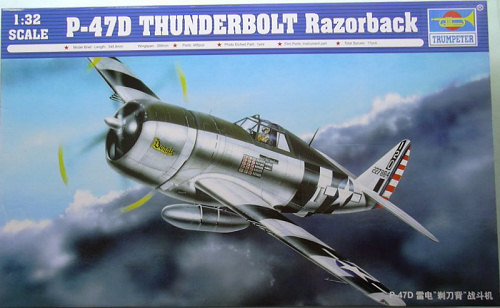
| KIT: | Trumpeter 1/32 P-47D 'Razorback' Thunderbolt |
| KIT #: | 2262 |
| PRICE: | $124.95 |
| DECALS: | Two options |
| REVIEWER: | Tom Cleaver |
| NOTES: |

| HISTORY |
In the most recent issue of "Flight Journal," famed Grumman test pilot Corky Meyer (the last actual "airplane person" to head a major airplane company) named the P-47 Thunderbolt the "best fighter of World War II - ETO." As he pointed out, it had high performance, yet a wartime-trained 200-hour pilot could fly it, with a well laid-out cockpit in which all the controls, switches, and instruments were handily located. It exceeded at three of the four performance parameters he established: air combat capability, fighter escort capability, ground support capability and photo-reconnaissance (it only missed on the latter). With 15,683 Thunderbolts produced between 1941-45, it is the most-produced American fighter ever. Republic delivered one in 1941, 532 in 1942, 4,428 in 1943, 7,065 in 1944 and 3,657 in 1945. 730 were operated by the RAF in Southeast Asia, while 446 flew for the French Air Force in Europe. The only theater of war in which the Thunderbolt did not fight was in Alaska; it is telling that the two top-scoring American fighter pilots in the ETO both flew P-47s exclusively, and all 10 of the top P-47 aces in the ETO survived the war. By D-Day there were 17 P-47 Fighter Groups stationed in England, and in the next eleven months, they swept across western Europe like an aerial scythe.
| THE KIT |
This is the second P-47D “Razorback” Thunderbolt to be released, the first being from Revell, issued in the 1970s. This kit effectively makes that kit obsolete on all counts other than price.
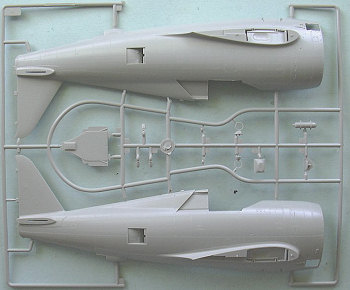 There has been a lot of
yakkety-yak at That Other Place by the well-known hexpurtz (they know who they
are and will be glad to inform you) as to whether or not the Trumpeter P-47D,
with a MSRP of $124.95, is “three times better” than the Hasegawa P-47D which
lists in the United States for around $45. As usual, the hexpurtz get it wrong,
since they are trying to compare grapes and pears. The two kits are designed to
fill different niches.
There has been a lot of
yakkety-yak at That Other Place by the well-known hexpurtz (they know who they
are and will be glad to inform you) as to whether or not the Trumpeter P-47D,
with a MSRP of $124.95, is “three times better” than the Hasegawa P-47D which
lists in the United States for around $45. As usual, the hexpurtz get it wrong,
since they are trying to compare grapes and pears. The two kits are designed to
fill different niches.
The Hasegawa kit is “basic.” This is in line with Hasegawa’s long-held philosophy of providing a basic kit that will make up into an acceptable model, leaving the additional detail some modelers want to the aftermarket. As such, the kit makes up into a good model, and those who wish to have a more detailed cockpit or engine can get them from the aftermarket resin manufacturers. There is nothing wrong with the kit at all and it provides good value for the price.
The
Trumpeter kit is a bit more ambitious, with four times as many parts - 428 in
all - in 17 sprues.. All control surfaces are separate, allowing a modeler to
pose them dynamically. Full detail is provided for the guns and gunbays, t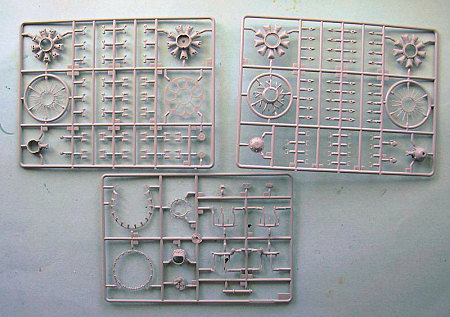 he
turbosupercharger, the accessories area behind the engine, and the engine
itself. About the only thing a modeler would need to add to these areas would
be electrical wiring. Anyone who wants to make an “opened-up” model has pretty
much everything they would need.
he
turbosupercharger, the accessories area behind the engine, and the engine
itself. About the only thing a modeler would need to add to these areas would
be electrical wiring. Anyone who wants to make an “opened-up” model has pretty
much everything they would need.
The cockpits of each kit are pretty much similar in overall quality, and the vast majority of modelers will be perfectly happy with what’s there, only needing to get hold of Eduard’s new photoetch seatbelts to give the cockpit a good level of detail.
There has been a lot of hoorah about the surface detail of this kit, since it
has engraved rivets and the P-47 was flush riveted. As anyone who has read my
reviews knows, I mostly don’t like this phenomenon in modeling. That said,
anyone who had no problem with the engraved rivet detail on the Trumpeter Me-262
(and I didn’t have a problem there) will have no problem with this surface
detail, which is petite and restrained, and not much more than someone
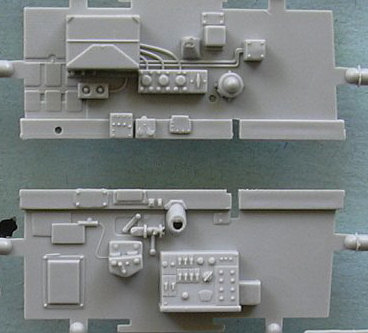 would achieve if they pulled out
their “riveting tool” and riveted away on the surface. I think it will even
look all right in a natural metal finish and will certainly look OK in a
camouflage scheme.
would achieve if they pulled out
their “riveting tool” and riveted away on the surface. I think it will even
look all right in a natural metal finish and will certainly look OK in a
camouflage scheme.
Where the kit really shines is the provision of drop tanks and ordnance. Every kind of drop tank the P-47 ever carried is provided here. There are two 500-lb bombs, two 250-lb bombs, and two of the 3-tube bazooka sets. Six 5-inch HVARs and their associated rails are also provided, though the early P-47 never carried them. Thus, a modeler who wanted to adequately arm their Hasegawa P-47D or use ETO “paper tanks” will have them left over from this kit. Let me see, those would probably go for a good $25-$30 in the aftermarket resin sets (that don’t exist).
Additionally, the kit provides ever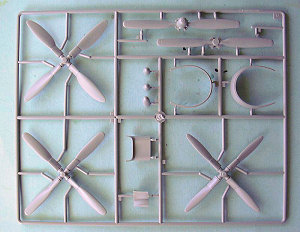 y
prop used by the P-47, from the Curtiss Electric “toothpick” to the first paddle
prop, to the Ham-Standard prop, to the later Curtiss-Electric “big paddle” used
by the P-47M and P-47N. Thus, the modeler who can’t wait to turn his Hasegawa
kit into a P-47M has the necessary prop here, as well as the correct “big bolt”
crankcase housing. I know the “big paddle” prop is $10 from Jerry Rutman in
resin.
y
prop used by the P-47, from the Curtiss Electric “toothpick” to the first paddle
prop, to the Ham-Standard prop, to the later Curtiss-Electric “big paddle” used
by the P-47M and P-47N. Thus, the modeler who can’t wait to turn his Hasegawa
kit into a P-47M has the necessary prop here, as well as the correct “big bolt”
crankcase housing. I know the “big paddle” prop is $10 from Jerry Rutman in
resin.
So, the kit has a good $30-$40 worth of “goodies” that can be used on the Hasegawa kit to good effect.
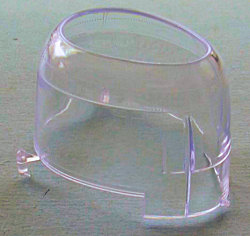 I particularly like the fact
that the cowling is molded in one piece, since the assembly of the multi-part
Hasegawa cowling gave me more fits than I ever had with DML Fw-190A models. The
cowling flaps provided - in both open and closed alternatives - are strictly the
later “notched” version, but it would not be hard at all to replace the lower
two flaps with “full-chord” flaps made from Evergreen sheet to do the earlier
P-47D-1 to P-47D-11.
I particularly like the fact
that the cowling is molded in one piece, since the assembly of the multi-part
Hasegawa cowling gave me more fits than I ever had with DML Fw-190A models. The
cowling flaps provided - in both open and closed alternatives - are strictly the
later “notched” version, but it would not be hard at all to replace the lower
two flaps with “full-chord” flaps made from Evergreen sheet to do the earlier
P-47D-1 to P-47D-11.
The tires are rubber, but - while I don’t like them - I have Trumpeter kits that are now approaching five years in age and have had no problem with the rubber tires melting the landing gear as was the case with other manufacturer’s rubber tires, so I don’t find them a problem.
As is unfortunately usual with Trumpeter kits, the decals are a dud. The markings for Major Bill Dunham’s “Bonnie” are done right off the cover of the Squadron “In Action” book, and are wrong. The “Donald Duck” for the alternative is also incorrect, and Trumpeter still doesn’t seem able to get the right proportions to U.S. national insignia. Fortunately, I know of several really good sheets of aftermarket decals that are going to be available in the not-too-distant future, so this is not going to be a problem. Additionally, if you can lay hands on the old Micro-Scale sheets released for the Revell kit, these are also good.
| CONCLUSIONS |
The Trumpeter P-47D “Razorback” is an excellent kit that provides good value for money. With the separate controls and the added interior details, modelers have everything they need to start with in producing a contest-winning model. Since the kit will likely be available from online sources for less than the MSRP, the sturm und drang about the price is probably irrelevant. Those who don’t want it won’t buy it and those who do will. To me, it represents good value for its price even at the MSRP and I recommend it to those who like the Thunderbolt. It beats the socks off the other 1/32 Razorback on everything but price.
Thanks to Stevens International for the review kit.
August 2007
If you would like your product reviewed fairly and quickly by a site that has nearly 400,000 visitors a month, please contact me or see other details in the Note to Contributors.